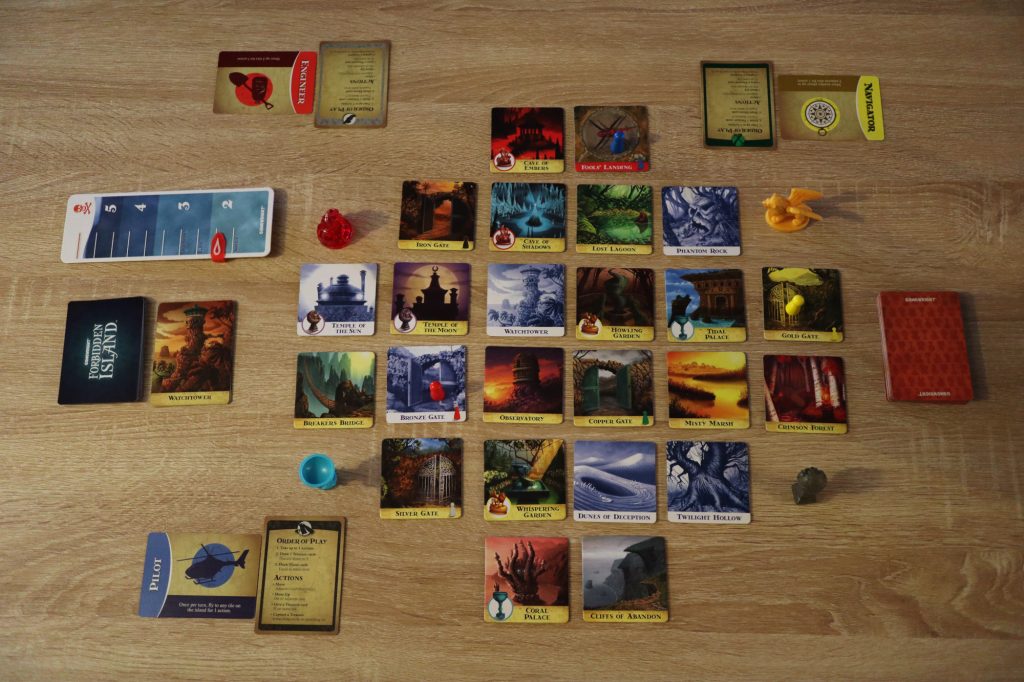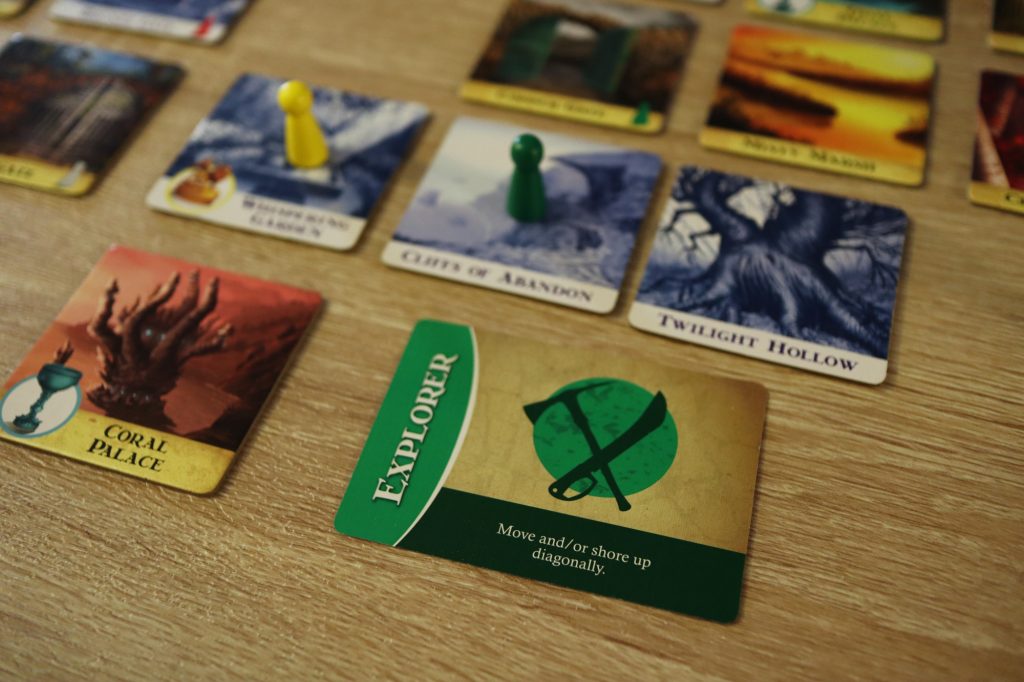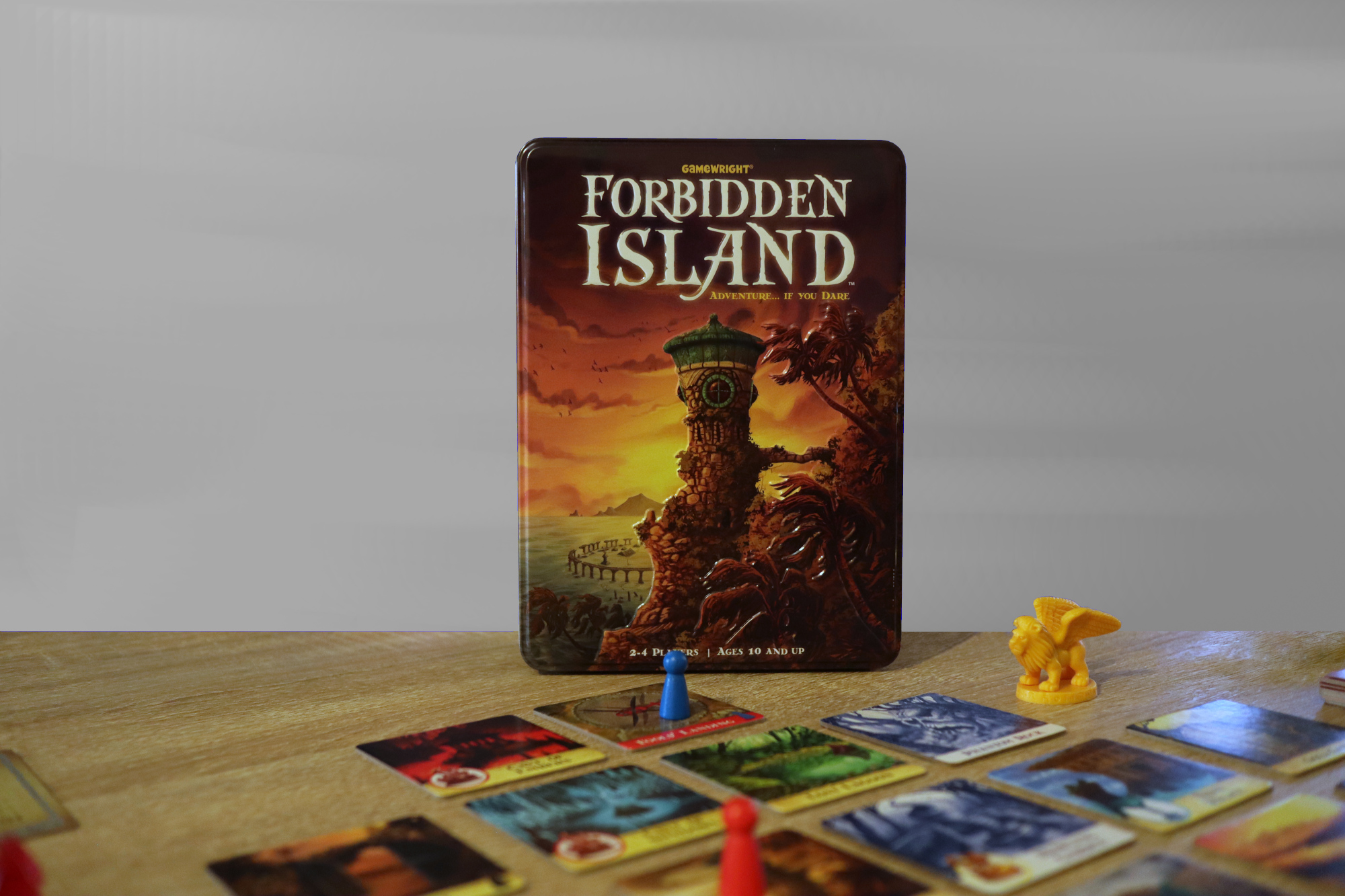Forbidden Island is a cooperative board game from famed designer Matt Leacock, where players take up the roles of adventurers on a sinking island. Published by Gamewright and originally released back in 2010, 2 – 4 players will spend around 30 minutes on the island attempting to save local treasures. Working together, adventurers will move around the slowly flooding and sinking island, with locations eventually being fully submerged. However, will players want to journey here or it is more a holiday from hell? Let’s find out!
Setup is relatively fast and sees much of the content randomised. Shuffling the location tiles, the island is created in the middle of the table, with a layout using all 24 location tiles. Players are then randomly dealt a character card. Players take the player pawn of the same colour as their character, and place it onto the tile with the matching pawn symbol. Choosing a difficulty, players put a clip onto the water meter at the appropriate water level (from novice to legendary). The treasure and flood decks of cards are shuffled. Before the game even begins parts of the island are flooded. The top 6 cards from the flood deck are revealed. The locations revealed become flooded, with the matching location tile flipped to indicate this. Each player gains two treasure cards to start with and the game is ready to begin.
Players are tasked with saving 4 treasures from the Forbidden Island. Each is obtained by trading in a set of matching cards to one of two locations specific to the treasure type. The team must collect the four treasures and then escape the island via the helicopter, waiting for them at Fools’ Landing. To do this players will have to work together, stopping flooded locations from sinking and giving treasure cards to gain sets.
On a player’s turn they have 3 action points. These can be spent to do any combination of the four available actions. The most commonly used action is to move, which sees the player move their pawn to an orthogonal tile (up, down, left or right). At a flooded location, or orthogonal to one, a player can spend an action point to shore up a location tile. This sees a flooded tile flipped back to the un-flooded side. If on the same location as another player pawn the active player can, for an action point, give one of their treasure cards to the other player. Note that players have a hand limit of 5 cards: going over this forces a player to discard cards.

The final action available to a player gets the team a step closer to victory. Getting to one of the two location tiles with a treasure symbol and discarding 4 treasure cards matching that type sees that treasure rescued by the team. Regardless of the 3 actions taken the player must then draw 2 treasure cards. If either of these is a water rises card a special event occurs. Players shift the tracker up the water meter one step before shuffling all of the discarded flood cards and placing them back on top of the flood deck.
Between players turns the board fights back. Flipping a number of cards from the top of the flood deck, equal to the number indicated on the water meter, location tiles are flooded. Each tile has a matching card in the deck. When revealed, if the tile is on the un-flooded side it is flipped to the flooded side – like during setup. If the tile is already on the flooded side the location tile and flood card are removed from play. Not only can players no longer move onto this location in the grid, it could also lose them the game.
Players win by collecting the 4 treasures and getting out by discarding a helicopter card while everyone is on the Fools’ Landing location. Players can therefore lose the game if they are unable to get one of the treasures or the Fools’ Landing location sinks. If a player is on a flooded location as it sinks they can instantly swim to an orthogonal tile. If there isn’t one available then the character is lost and the team collectively loses.
To make the game harder there are difficulty levels. These see players start higher up the water meter track, thus needing to reveal more locations to flood from the offset of the game. The game is incredibly simple to pick up and play and yet it is far from simple to beat. Even gamers that play things all of the time will struggle on normal difficulty, with even novice going down to the wire. As small as the way to change the difficulty level sounds, it really does have an impact. Though it would have been nice to see a different island layout providing a different way to boost the difficulty.

While the island does always stay the same shape there is a decent amount of variety from one game to the next. The location tiles are randomised during setup, so in one game the Fools’ Landing tile could be in the center with fairly easy access. In another game it could be one of the edge tiles, and with only a sunken tile or two it could quickly become almost inaccessible. Adding another wave of variety are the characters. Each offers the player a unique way to effectively break the rules, from the explorer being able to move and shore up locations diagonally to the pilots ability to move to any location on the board. With 6 characters included, and the game playing with up to 4, there are always some left behind in the box. Importantly, the abilities available for the team need to be taken into account to win.
Forbidden Island is a gateway style game. After a quick example of what a flooded tile looks like and a demonstration of a turn, new players instantly know what to do, and how to win. While they will have their own special ability from their character card, the simple core of the experience allows new players to work out what they want to do, rather than panic about what they can do.
Much of the game is about either fixing the floods or doing hand management to be able to trade in four matching cards to rescue a treasure. These two aspects are both driven by what comes out of the flood and treasure decks respectively. Luck is therefore a factor to winning and losing, with unlucky card draws seeing a needed location sunk or the waters rise very quickly. Despite this deck based luck the game doesn’t feel too far removed from players control. For example, the knowledge of what cards could be drawn help guide decisions and thematically a sinking island probably wouldn’t flood in an overly non-random way.
The designer of Forbidden Island is very clearly Matt Leacock, with the game having firm roots from the cooperative experience of Pandemic. Players do spend less actions on a turn. Still, the objectives to collect sets of cards, move around a board and the way the board fights back are all highly reminiscent of Pandemic. Yet, Forbidden Island manages to offer something that the Pandemic series didn’t, a fun and shorter experience. Pandemic Hot Zone North America tried to but ultimately failed to reproduce the epic Pandemic feel, with the tension not captivated. Forbidden Island has the constant pressure of the island slowly sinking and crams it all into 30 minutes, making it easier to get the game to the table.
The four treasure pieces are the components that stand out from the rest at first glance. However, when playing the glorious illustrations on every tile shine through. The board made from the tiles isn’t just nice to look at either. Having such a clearly readable board, players can instantly look and tell where is flooded – leaving the experience to flourish. With a randomised setup it could have taken players a lot of time to locate tiles for flooding, but this potential issue is fixed thanks to the art design.
Forbidden Island is like Pandemic’s little brother in many ways. From the scope, players are saving items on an island instead of saving the world, to the game length, Forbidden Island is smaller. Even the box is smaller, with the game coming in a metal tin. However, the tension of what will be revealed from the decks, the way each turn has something important to do and the sense of satisfaction when you finally beat the game are all 100% there. Forbidden Island is a great gateway cooperative game, which can be enjoyed by those new to the hobby or deep into it, all with a solid theme, eye catching components and a game you will want to beat!
(Editor’s Note: Forbidden Island was provided to us by Coiledspring Games for the review. The game is currently available from local board game stores! Find your local store here.)

